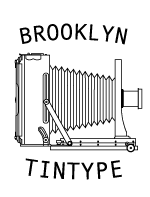- No products in the cart.


Wet-Plate Collodion is a photographic process that was invented in the 1850s and was in use during the same period as the daguerrotype. For a span of a few decades, it was considered the polaroid of the era. However, the unpredictability of this early process ensured that its life as the industry standard was short lived. Long exposure times, a 15 minute working time between coating and developing a plate and the volatile chemistry were some of the reasons Wet-Plate was eventually phased out for more stable and reliable media. However, it is because of these reasons, as well as the hyper-crisp sharpness, the hands-on technique, and expressive quality of its artifacts that Wet-Plate is reappearing in the photographic dialogue for both artists and professionals.
Technically speaking, Wet-Plate Collodion is a DIY process where the photographer makes everything. The film is made by hand from the stage of mixing chemicals, cutting and preparing tin or glass, coating a plate, exposing and developing it. The process is called “Wet-Plate” because the working time between coating and developing is about 15 minutes–while the plate is still wet. The cameras used are often large-format view cameras with modified film holders or custom plate backs, although there are many alternatives including modified polaroid cameras or building a view camera from foam core or wood. In the field, coating and developing must be done in a portable dark-room on site, which can be a box or suitcase with a red filter for sunlight.
Because collodion film is extremely slow (around 0.5 ASA) and orthochromatic (only sensitive to blue light), images can only be taken with high-intensity light– either natural daylight or special studio lights that contain UV spectrum light between 350-420nm. It’s typical for collodion photographers to give up the use of traditional light meters, learning how to read light by eye, based on experience.
With Collodion it is possible to shoot positives or negatives depending on the material used as a substrate. Metals and glass are the preferred substrates; plastics can be dissolved by the chemicals. The “type” changes depending on the substrate: tintypes are on “tin”, ambrotypes are on glass. Tintypes are always positives and thus they are one-of-a-kind prints that cannot be enlarged. Ambrotypes can be negatives or positives depending on the color of the glass.
Client List
The Blue School
Brain Pickings
Dispatches from Elsewhere (AMC)
GOOP
Pioneer Works
Scientific Controversies
Stefanie Cove and Company
